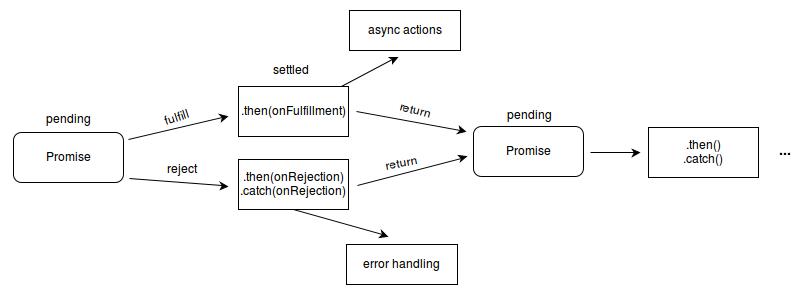背景
Promise是JavaScript的内置对象,一般用于包装异步请求,再配合async/await语法,可以让代码可读性更好。
Promise也是前端面试的必考题。作为一名前端开发人员,有必要更深入理解Promise的内部运行机制,以及做相关的功能拓展。
Promise
Promise 对象用于表示一个异步操作的最终完成 (或失败)及其结果值。
Promise 首先是一个对象,它通常用于描述现在开始执行,一段时间后才能获得结果的行为(异步行为),内部保存了该异步行为的结果。然后,它还是一个有状态的对象:
- pending:待定
- fulfilled:兑现,有时候也叫解决(resolved)
- rejected:拒绝
一个 Promise 只有这 3 种状态,且状态的转换过程有且仅有 2 种:
- pending 到 fulfilled
- pending 到 rejected
因为 Promise.prototype.then 和 Promise.prototype.catch 方法返回的是 promise, 所以它们可以被链式调用。

可以通过如下的 Promise 对象构造器来创建一个 Promise:
1
| let promise = new Promise((resolve, reject) => {})
|
Promise的简单实现
要求
实现一个_Promise构造函数,满足一下代码的使用需求
1
2
3
4
5
6
7
8
9
10
11
12
13
| const getData = new _Promise((resolve, reject) => {
setTimeout(() => {
resolve('data')
}, 1000)
})
getData
.then(res => {
console.log(res)
}, error => {
console.log(error)
})
|
实现
1
2
3
4
5
6
7
8
9
10
11
12
13
14
15
16
17
18
19
20
21
22
23
24
25
26
27
28
29
| class _Promise {
constructor(fn) {
this.state = 'pending'
this.onFullFilled = null
this.onRejected = null
fn(this.resolve, this.reject)
}
then = (onFullFilled, onRejected) => {
this.onFullFilled = onFullFilled
this.onRejected = onRejected
}
resolve = data => {
this.state = 'fullFilled'
this.onFullFilled(data)
}
reject = error => {
this.state = 'rejected'
this.onRejected(error)
}
}
|
Promise.all的简单实现
要求
实现一个Promise._all函数,满足一下代码的使用需求
1
2
3
4
5
6
7
8
9
10
11
12
13
14
15
16
17
| const promise1 = new Promise((resolve, reject) => {
resolve(1);
});
const promise2 = new Promise((resolve, reject) => {
resolve(2);
});
const promise3 = new Promise((resolve, reject) => {
resolve(3);
});
Promise._all([promise1, promise2, promise3])
.then(res => {
console.log(res);
}, error => {
console.log(error)
})
|
实现
1
2
3
4
5
6
7
8
9
10
11
12
13
14
15
16
17
18
19
| Promise._all = promises => {
const resList = []
let count = 0
return new Promise((resolve, reject) => {
promises.forEach((item, index) => {
item
.then(res => {
count++
resList[index] = res
if (count === promises.length) {
resolve(resList)
}
}, error => {
reject(error)
})
})
})
}
|
Promise并发限制
要求
我们在需要保证代码在多个异步处理之后执行,我们通常会使用
1
| Promise.all(promises: []).then(fun: function);
|
Promise.all可以保证,promises数组中所有promise对象都达到resolve状态,才执行then回调
那么会出现的情况是,你在瞬间发出几十万http请求(tcp连接数不足可能造成等待),或者堆积了无数调用栈导致内存溢出
这个时候需要我们对HTTP的连接数做限制。
1
2
3
4
5
6
7
8
9
10
11
12
13
14
15
16
17
18
19
20
21
22
23
24
| const urls = [
'bytedance.com',
'tencent.com',
'alibaba.com',
'microsoft.com',
'apple.com',
'hulu.com',
'amazon.com',
]
const requestFn = url => {
return new Promise(resolve => {
setTimeout(() => {
resolve(`任务${url}数据`)
}, 1000)
})
}
const promiseProducers = urls.map(item => requestFn.bind(null, item))
const pool = new PromisePool(promiseProducers, 3)
pool.start()
.then(res => {
console.log(res)
})
|
实现
1
2
3
4
5
6
7
8
9
10
11
12
13
14
15
16
17
18
19
20
21
22
23
24
25
26
27
28
29
30
31
32
33
34
35
36
37
38
39
40
41
42
43
44
45
46
47
48
49
| class PromisePool {
constructor(promiseProducers, limit) {
this.promiseProducers = promiseProducers
this.limit = limit
this.res = []
this.index = limit - 1
this.sum = promiseProducers.length
this.count = 0
this.resolve = null
}
start() {
const curPromiseProducers = this.promiseProducers.splice(0, this.limit)
curPromiseProducers.forEach((item, index) => {
this.runTask(item, index)
})
return new Promise(resolve => {
this.resolve = resolve
})
}
runTask(promiseProducer, index) {
promiseProducer().then(res => {
this.res[index] = res
this.count++
if (this.promiseProducers.length > 0) {
this.index++
this.runTask(this.promiseProducers.shift(), this.index)
}
if (this.count === this.sum) {
this.resolve(this.res)
}
})
}
}
|




